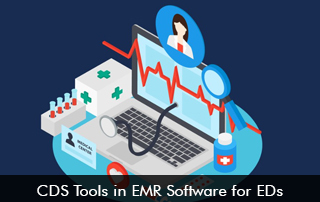Healthcare providers focus on providing the best possible care to their patients conduct research and continue with advanced studies to improve healthcare delivery and stay updated with the new techniques when it comes to the treatment of different health conditions.
Emergency departments in hospitals usually have high patient volumes and there is always a risk of potential medical errors. To reduce the number of medical risks and improve patient safety, clinical team members in the ED make use of healthcare technology tools such as Electronic Medical Records (EMR) Software, EHR Software, and clinical decision support tools (CDS).
What is Clinical Decision Support (CDS)?
According to a report from Health Information Technology, CDS features include automatic alerts and reminders for providers and patients, clinical guidelines, and customized patient data reports with patient summaries.
The use of these powerful tools present in EMR Software systems helps healthcare providers get accurate details at the right time. When information is available in real-time doctors can work seamlessly. CDS tools also include documentation templates support to facilitate patient diagnosis at the point of care. The Agency for Healthcare Research and Quality tells healthcare professionals that CDS tools provide accurate and prompt information at the point of care to support decision-making.
Common Features in CDS Tools within EMR Software
- Automated alerts and reminders
- Evidence-based clinical guidelines
- Drug interaction checks
- Diagnostic decision support
- Risk assessment tools
- Clinical pathways
- Workflow integration
- Order sets and templates
- Patient education resources
CDS features in EMR software are always evolving to accommodate new clinical guidelines, technological advances, and healthcare issues, to improve patient care, enhance outcomes, and streamline clinical workflows for healthcare providers.
Top 4 Reasons to Use CDS Tools in EHR Systems in Hospital Emergency Departments
- Reduction in Medication Errors – Nurses and doctors need to give accurate medication dosages according to weight and age in critical circumstances to infants and children in the ED. This is where CDS tools in EMR Software come in handy as they give quick access to drug-specific dosing calculators, comprising full drug monographs in accordance to age groups – This helps to reduce the risk of medication errors and enhance patient safety levels.
- Cut down on Misdiagnosis – Misdiagnosis accounts for 10 to 30 percent of medical errors. Misdiagnosis can occur due to cognitive miscalculations and atypical presentations. Clinical decision support is essential in circumstances when the diagnosis is not clear during a medical emergency. Clinicians in the hospital ED can leverage differential diagnosis support tools to quickly detect diagnostic opportunities.
- Provide trustworthy information to caregivers – At the point of care providers need to rely on consistent and reliable information to facilitate their decision-making process. When time is running short care teams don’t have the time to sift through article abstracts from Medline. CDS tools in electronic health records software provide trusted resources and data that can be quickly accessible to make an accurate decision that can positively impact patient outcome levels.
- Information is stored in a central place – Electronic clinical decision support systems make available easy access to updated medical resources and information in a single location. This eliminates the need for hospitals to invest in other resources and doesn’t take up any tangible space in the emergency department. Having information in one place, everyone can access it efficiently to benefit the patient that is being treated.
Final Takeaway
Adapting a CDS system in ED empowers providers with the most accurate patient diagnosis and helps improve efficiencies in times of critical situations. Potential medication risks can be reduced and enhance patient quality of care which is the ultimate goal of every physician.







